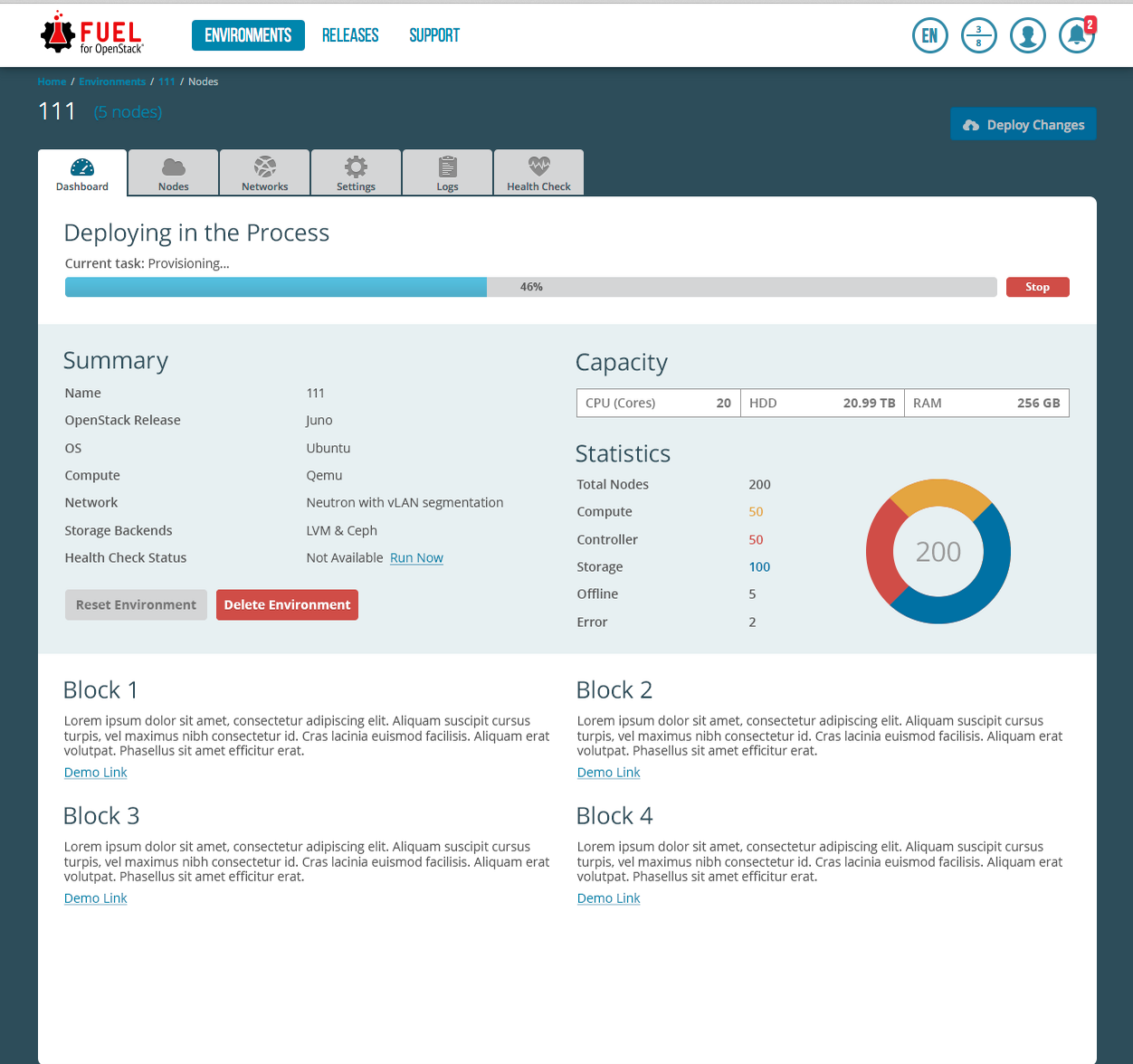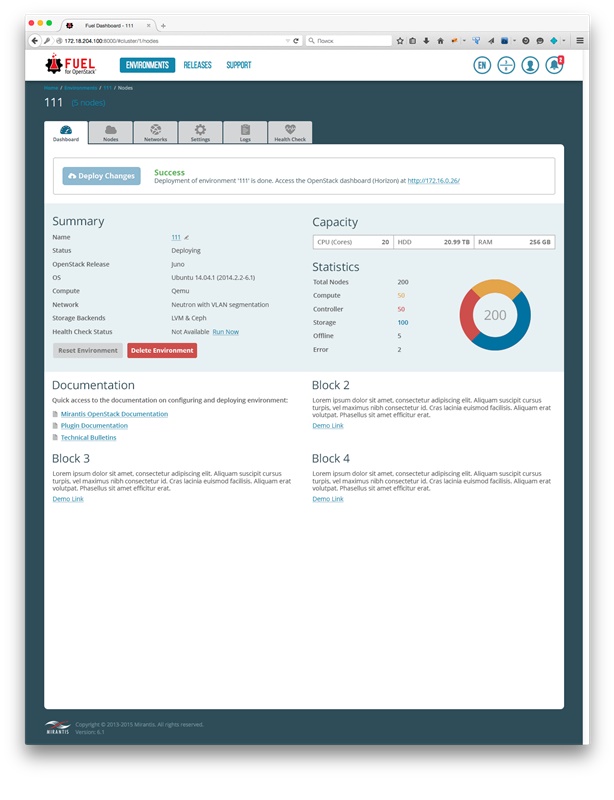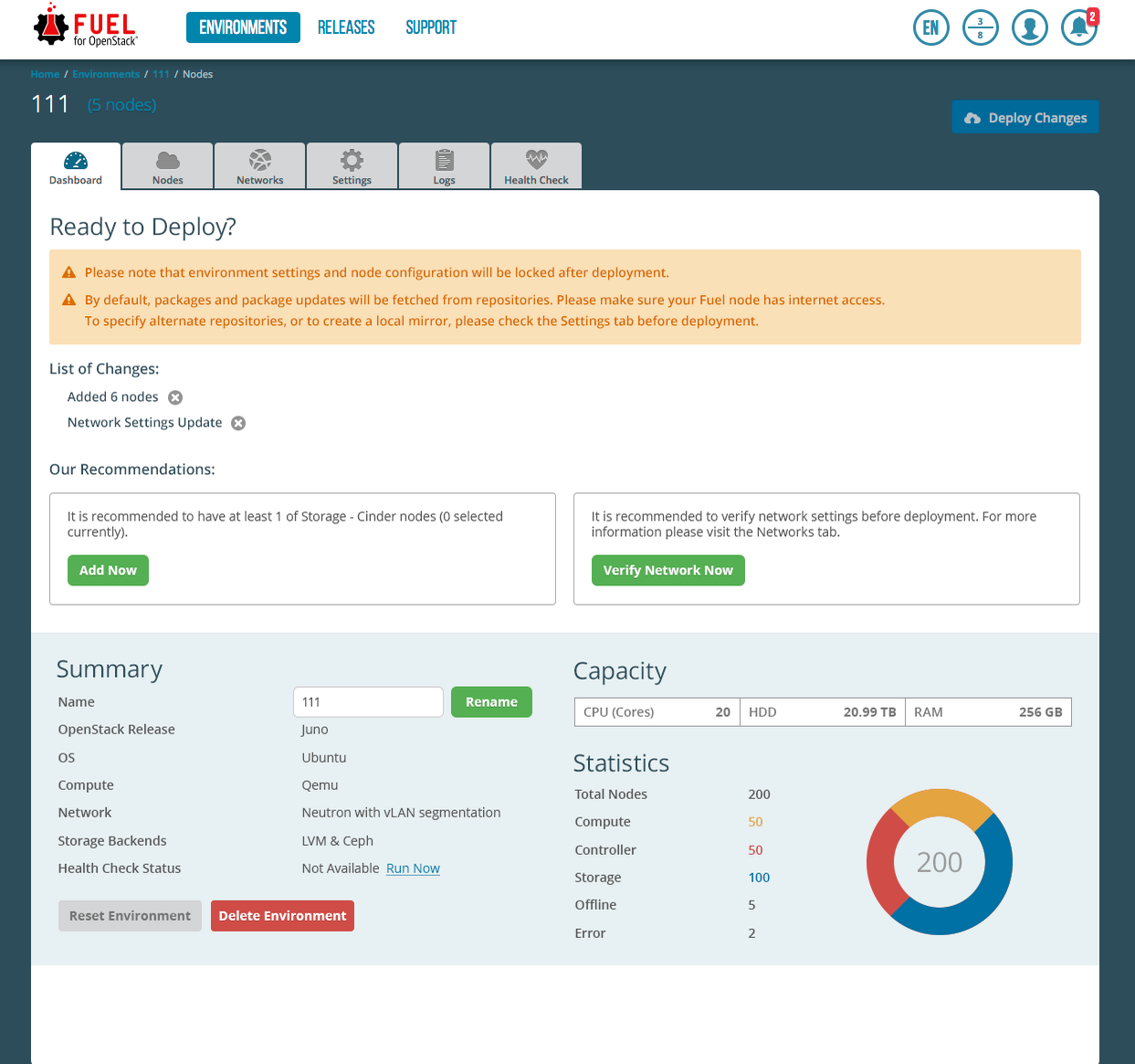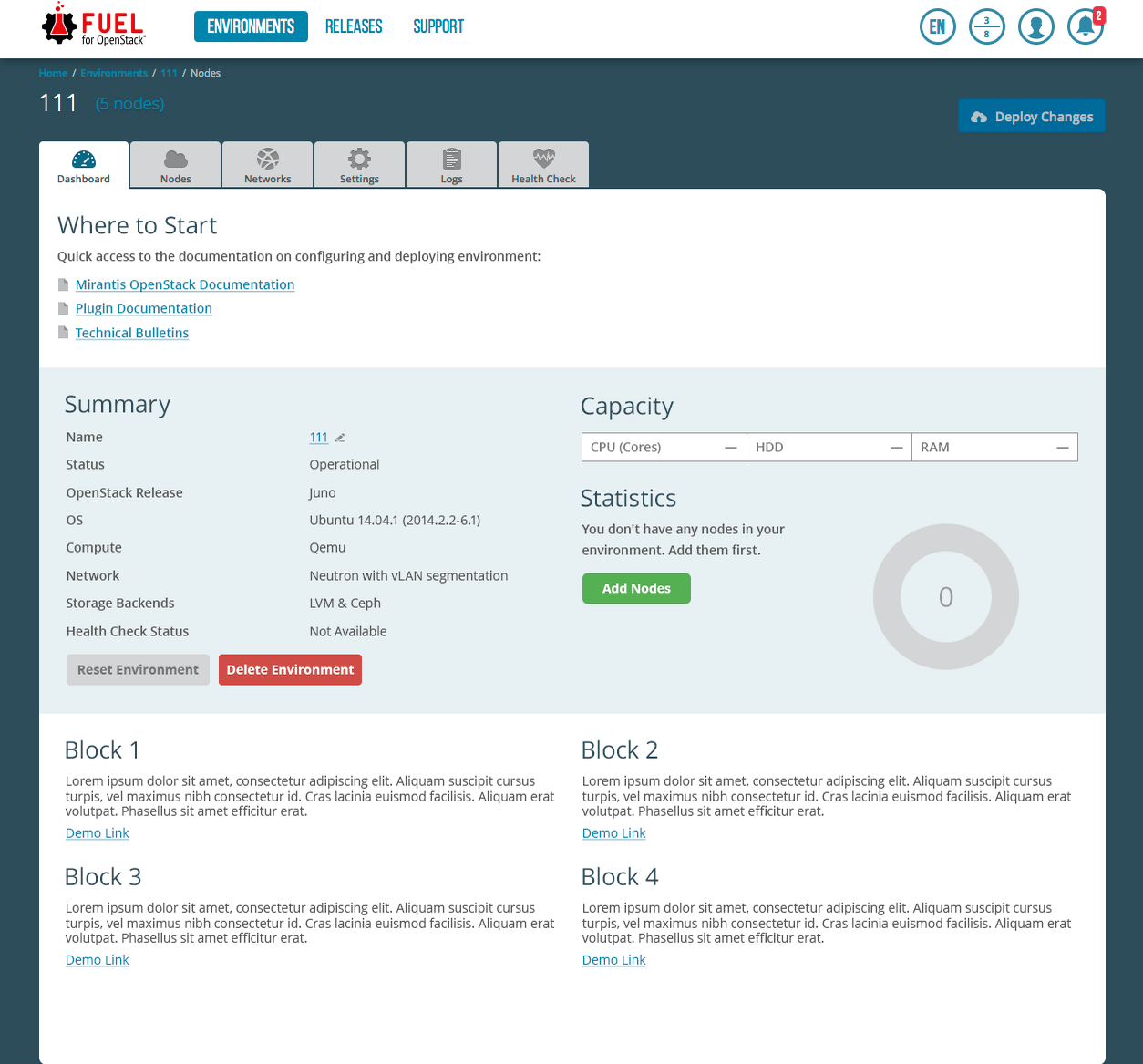OpenStack environment Dashboard¶
https://blueprints.launchpad.net/fuel/+spec/post-deployment-dashboard
Create a single entry point for user to have access to all the necessary information before, in progress and after deployment.
Problem description¶
It might be quite hard for a newbie user to understand what he should do after OpenStack environment creation. To help user setup the OpenStack environment and show what can be done with it we’ll introduce dashboard. Dashboard will accumulate information about the OpenStack environment It also will give the user an idea of what to do next and what in general can be done with OpenStack environment.
Proposed change¶
Create a separate tab in UI combining all the necessary information and useful links for the user. This tab will also replace current Actions tab, combining data from there.
The main information should be displayed in the separate block - with instructions what to do next and what currently is wrong.
For the new just-created OpenStack environment there should be:
- link to Add nodes screen with warning No nodes added to OpenStack environment
- for OpenStack environments with nodes, but no network verification - corresponding warning and link to Networks tab
To be short - all warnings and errors, shown in Deploy changes dialog should be shown here.
For deployed OpenStack environment there will be link to Horizon, OSTF tests status with link to Healthcheck tab. For new OpenStack environment Healthcheck block will be shown but disabled.
For error OpenStack environment here will be error message, replacing the one under OpenStack environment page breadcrumbs.
The additional content here will be:
- nodes statistics - number of online nodes in OpenStack environments, in graph view, donut chart. Number of error nodes - just in red (in case of error offline node this node will be counted as an error one)
- link to plugins documentation
- link to Openstack documentation
- storage backend info - what volume and image type is selected (Cinder or Ceph) (is needed to know in order to not search this information through the whole settings tab)
- other OpenStack environment information (in one cumulated block) - OpenStack environment name, operating system, OpenStack release, selected compute hypervisors (KVM, QEMU with vCenter or not), network option (Neutron or Nova)
- nodes configuration (HDD, CPU, RAM)
- urls, provided by plugins(services like Murano, Sahara, Ceilometer are treated as plugins also) via API described in corresponding chapter REST API impact. Plugin entries will be displayed in the order of date creation.
The suggestion is to have a unified source of truth for either deployed OpenStack environment and a new one, this tab would be the first one and Nodes tab will go after it.
The proposed mockups of dashboard: for new OpenStack environment:
For new OpenStack environment being deployed:

For OpenStack environment already deployed:

and in case of warnings:

For nailgun¶
Provide API with links to all possible necessary resources after OpenStack environment deployment.
- link to Horizon
- link to Zabbix
- link to Murano (description and what to do with it)
- link to Sahara (description and what to do with it)
- link to Ceilometer (description and what to do with it)
- any other links provided by plugins
We’ll have special /cluster/:id/dashboard_entries url by GETting which it will be possible to get the list of dashboard entries in the format like this:
[
{
title: 'plugin',
description: '',
url: '',
id: Number
}
]
with optional ‘description’ field.
To solve authentication issues we’ll use auth exemption.
For UI¶
UX will be affected in several aspects with this change:
- Actions tab will be substituted with Dashboard tab, providing all the necessary info about the OpenStack environment for the user
- Deploy button will be moved to Dashboard
- Deployment result message (both success and error or warning-containing) will be moved to dashboard
- Deployment/resetting/stopping progress will be displayed on the Dashboard tab
- List of changes will be displayed on the dashboard replacing Deploy Changes dialog
- Discard changes button will be moved to Dashboard
Alternatives¶
None
Data model impact¶
The new table for dashboard entries should be created, containing the following fields:
| id | Title | Description | url | cluster_id |
|---|---|---|---|---|
| id | String | String | String | id | |
cluster_id field means one cluster may have many dashboard entries for plugin, but it will belong to one cluster (one-to-many relationship)
REST API impact¶
API POST, PUT and DELETE method should be available for plugins in their post- deployment hooks.
There will be a new REST API url added:
| method | URL | action | auth exempt |
|---|---|---|---|
| POST | /api/v1/clusters/:cluster_id/ dashboard_entries | create a new item for dashboard entries | true |
| GET | /api/v1/clusters/:cluster_id/ dashboard_entries |
|
false |
| PUT | /api/v1/clusters/:cluster_id/ dashboard_entries/:entry_id |
|
false |
| DELETE | /api/v1/clusters/:cluster_id/ dashboard_entries/:entry_id | delete a dashboard entry with specified id | false |
GET returns JSON like this:
[
{
title: 'Zabbix',
description: 'Zabbix is software that monitors numerous' +
+ 'parameters of a network and the health and integrity' +
+ ' of servers',
url: 'http://www.zabbix.com/',
id: Number(identificator)
},
{
title: 'Murano',
url: 'https://wiki.openstack.org/wiki/Murano',
id: Number(identificator)
},
{
title: 'My plugin',
description: 'My awesome plugin',
url: '/my_plugin',
id: Number(identificator)
}
]
Upgrade impact¶
A migration should be created for DashboardEntries model, also migrations are needed to generate dashboard entries for old OpenStack environments - for Horizon, Sahara and Murano entries.
Security impact¶
None
Notifications impact¶
Unlikely.
Other end user impact¶
Will improve user experience. Unlikely to impact python-fuelclient.
Performance Impact¶
None.
Plugin impact¶
Will provide an entry point for plugins to access post-deployment dashboard.
Other deployer impact¶
None.
Developer impact¶
None.
Implementation¶
Assignee(s)¶
- Primary assignee:
- Aleksandra Morozova <astepanchuk@mirantis.com>
- Other contributors:
- Bogdan Dudko <bdudko@mirantis.com> - designer
- Steve Doll <sdoll@mirantis.com> - designer
- Vitaly Kramskikh <vkramskikh@mirantis.com> - backend developer
- Approver:
- Nathan Trueblood <ntrueblood@mirantis.com>
- Sheena Gregson <sgregson@mirantis.com>
- Reviewer:
- Vitaly Kramskikh <vkramskikh@mirantis.com>
Work Items¶
Blueprint will be implemented in several stages:
- Initial design and logic approval
- Markup implementation
- Javascript React components implementation
- Backend implementation
Dependencies¶
None
Testing¶
Tests to be created for new REST API items. UI side of Dashboard implementation should also be covered with functional and unit tests - React components, new UX, new js model.
Acceptance criteria¶
User can access OpenStack documentation, list of changes, available actions, cumulated information and what is missing for OpenStack environment, also plugin urls will be shown on this separate Dashboard tab. Cumulated environment information, actions that can be done with environment and links to OpenStack documentation should always be visible for the user. Before deployment user can see list of changes, a list of warnings/errors if any in addition to information displayed always. In the process of environment deployment, user can see current deployment progress state, besides the information mentioned above. After OpenStack deployment has successfully completed, the default displayed tab shows links out to all relevant dashboards (Horizon, Murano, plugin UIs). If plugins were included, links should include plugin-relevant UI blocks. Changing plugin settings and/or removing plugins is not a part of this page.
Documentation Impact¶
Part about user flow, with new Dashboard tab should be updated.
